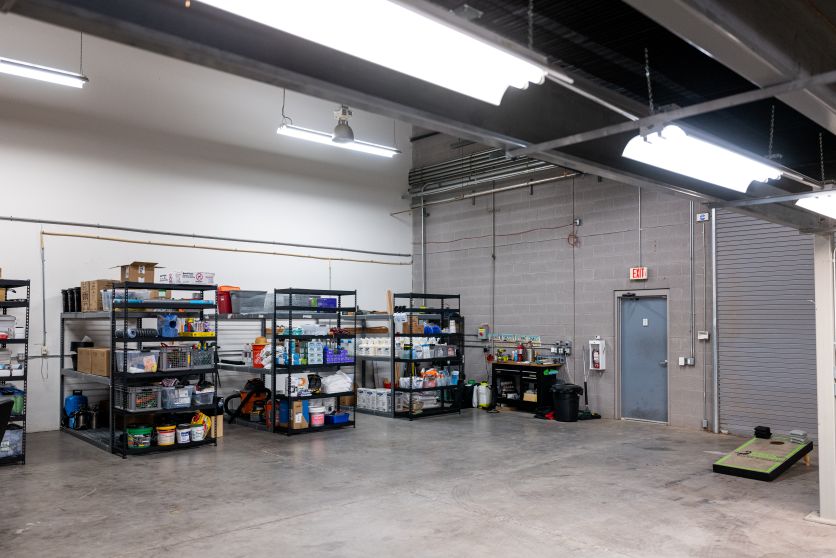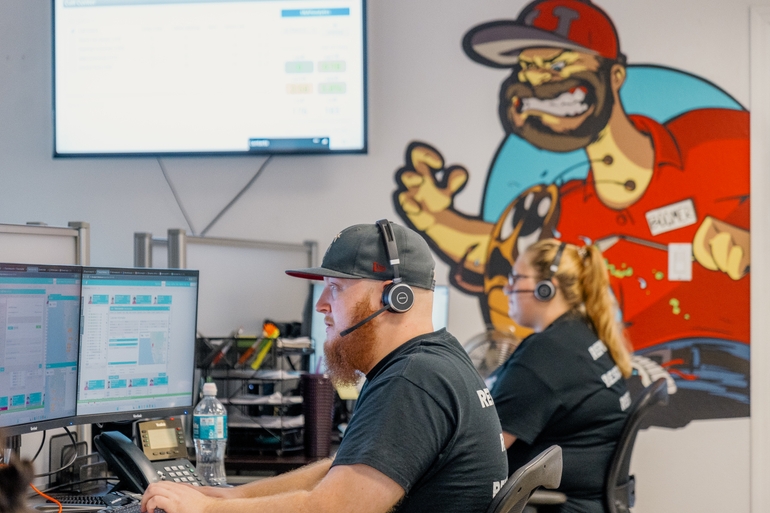Pest Control Inventory Management: 7 Best Practices

Good inventory management is key to reducing waste, downtime, and service quality for pest control companies. Poor oversight can mean overstocked pesticides, missing tools, or delayed treatments—all of which cost time and money.
This guide outlines seven best practices for pest control operators to help them organize, track, and optimize their inventory and equipment. Whether you’re an owner or manager, these will help streamline operations, increase profitability, and keep your business pest-ready.
1. Organize and Categorize Inventory
A well-organized inventory system saves time, cuts costs, and ensures technicians have what they need to tackle different pests effectively.
Poorly executed pest control treatments can turn minor issues into bigger problems, which is why professional services are so important.
Start by creating clear inventory categories. This simplifies retrieval and supports more efficient pest control services. Common categories include:
Chemicals and insecticides (pesticides, rodenticides, termite treatments)
Application tools (sprayers, bait stations, dusters)
Monitoring and trapping equipment (cockroach monitors, glue boards)
Personal protective equipment (gloves, respirators, suits)
Sanitation supplies and other preventative measures
Next, assign dedicated storage areas for each category and label shelving, bins, or cabinets. Keep items off the floor and away from walls to prevent contamination and identify signs of pest activity.
Use a consistent system to log inventory, such as printed checklists or pest control software that supports barcode scanning and real-time tracking. This will give you visibility and reduce downtime.
2. Implement Inventory Tracking Software
Manual trackingoften leads to errors, lost items, or inaccurate stock levels. Pest control software like FieldRoutes can automate the process and reduce costly mistakes year-round.
Modern software solutions offer:
Real-time inventory updates to avoid overstocking or understocking
Automated reordering alerts when supplies run low
Custom reporting to monitor pesticide use, technician needs, and pest activity
Integration with field teams to allocate products and tools per job or technician
Technicians can log usage directly from the field, so you have accurate data and better forecasting. This reduces downtime, increases customer satisfaction, and improves pest control.
Choose a system that supports your workflow and scales with your pest control business. Learn more about FieldRoutes’ automation tools for inventory management.
3. Regularly Audit and Update Inventory
Regular audits help pest control companies maintain accurate stock levels, reduce waste, and avoid service delays. Set a schedule—monthly or quarterly—to check inventory and equipment.
During each audit:
Count and verify current stock against software records or checklists
Inspect equipment like sprayers and traps for wear, damage, or missing parts
Check chemical labels for expiration dates and ensure proper storage conditions
Dispose of outdated insecticides and pesticides according to safety regulations
Retire or repair tools that no longer meet performance standards
Include termite control products in your inventory checks to ensure comprehensive pest management
Audits support better pest control by ensuring technicians have the right products and functional tools. They also help identify patterns in usage and potential issues with theft, overuse, or under-ordering.
For smoother audits, integrate an inventory tracking system to flag inconsistencies automatically.
Being proactive helps your pest control business optimize operations and meet service demands.
4. Forecast and Plan Ahead for Demand
Accurate forecasting prevents overstocking and ensures you’re prepared for pest activity spikes. Use historical data to predict inventory needs and keep your pest control services running smoothly.
Start by analyzing:
Seasonal pest infestations like termites in spring or cockroaches in warmer months
Product usage rates by location, technician, and type of pests treated
Previous years’ inventory data to predict future needs
Consider demand during peak seasons or following local outbreaks.
Use your pest control software to set reorder points based on past usage and real-time inventory updates.
Planning allows you to:
Avoid last-minute reorders
Reduce insecticide and rodenticide spoilage
Improve cash flow by buying only what you need
Provide re-treatment for returning pests at no extra cost
Matching orders to demand helps profitability and consistency of pest prevention services.
Thoughtful planning today means better operations tomorrow.
5. Streamline Reordering Processes
Simplifying your reordering process means pest control professionals always have the right tools, insecticides, and equipment, without overstocking or running out.
Use pest control software like FieldRoutes to:
Set automatic reorder points for high-use items like rodenticides and sprayers
Get low-inventory alerts based on real-time data
Track order history to refine future purchasing decisions
Build relationships with suppliers who understand your industry’s seasonal needs. Prioritise those with consistent delivery times and transparent pricing.
When deciding between bulk buying and just-in-time ordering:
Bulk buying may lower the price per unit and reduce supply chain disruptions
Just-in-time can help with cash flow and minimize storage requirements
It depends on your pest control business size, service frequency, and types of pests treated.
Automating reorders removes guesswork and improves inventory accuracy across your operations.
6. Train Technicians on Proper Equipment Use and Care
Well-trained technicians support effective pest control by using tools correctly, maintaining sanitation standards, and reducing downtime caused by broken or lost equipment.
Focus training on:
Safe handling of insecticides, rodenticides, and application tools
Proper storage of chemicals to avoid leaks, contamination, or exposure
Regular cleaning and maintenance of sprayers, bait stations, and PPE
Identifying early signs of wear or malfunction in equipment
Residential pest control is key to managing household pest issues. Trained exterminators use effective techniques to identify, remove, and prevent pests, giving homeowners peace of mind.
Use FieldRoutes to document training, assign refresher training, and maintain safety compliance across your pest control business.
Regular training helps:
Extend equipment life
Lower replacement costs
Improve technician performance and customer satisfaction
Support regulatory compliance and your overall IPM program
Train staff to log equipment usage and report issues through your pest control software. Training leads to smoother operations and better pest prevention.
7. Monitor Usage and Waste Management
Tracking usage helps reduce waste, save costs, and protect the environment. It also ensures your pest control company is compliant with industry regulations.
Use pest control software like FieldRoutes to:
Log insecticide and rodenticide usage per job or technician
Identify trends in overuse or underuse
Generate reports for audits and environmental reviews
Treat indoor and outdoor areas
Adopt eco-friendly practices to manage waste:
Dispose of expired pesticides according to local environmental guidelines
Use sealed containers for transporting and storing chemicals
Train staff on eco-friendly handling and spill prevention
Reducing waste reduces expenses, downtime, and risk of contamination in storage areas or vehicles.
Eco-friendly waste management maintains a professional image and builds trust with environmentally aware homeowners.
Why Is Inventory Management Important for Pest Control Businesses?
Accurate inventory management helps pest control businesses be efficient, reduce unnecessary costs, and deliver effective pest control services. It impacts everything from profitability to customer experience and compliance.
Mosquito control services for residential yards are key to customer satisfaction and preventing infestations.
By targeting specific pests during follow-up services and using products that identify and address entry points, businesses can improve the precision and effectiveness of their pest control methods.
1. Reduces costs and prevents waste
Poor inventory control leads to excess pesticides, expired insecticides, or misplaced tools, making it difficult to get rid of pests. Overstocking ties up capital and increases the risk of storing chemicals beyond their shelf life. Understocking causes delays and forces pest control operators to make last-minute purchases—usually at a higher cost.
Using inventory tracking tools, businesses can monitor product levels, follow the first-in, first-out (FIFO) method, and dispose of waste responsibly. This reduces financial waste and improves storage area management.
Non-chemical methods and chemical solutions can further enhance pest control, making them practical and environmentally friendly.
Reducing unused stock directly improves your pest control business’s bottom line.
2. Ensures technicians are always prepared
Technicians can’t solve pest problems without the right tools and treatments. When inventory is organized and up to date, every pest control professional has access to the necessary supplies, whether for termites, cockroaches, spiders, or rodent control. Delays caused by missing equipment or expired insecticides mean downtime and unhappy homeowners.
With real-time software integration, you can allocate products to field teams, and they’ll arrive fully prepared. This level of readiness increases productivity and supports effective pest control on every job.
3. Improves customer satisfaction
A pest control company with an organized inventory delivers faster and more efficient service.
Homeowners want quick and professional responses, especially during emergency pest infestations. When equipment and insecticides are available and functional, technicians can focus on resolving pest activity, including rodents, rather than managing supplies. This improves first-time fix rates, reduces follow-up visits, and increases trust.
Maintaining inventory helps your business stay pest-free, meet SLAs, and enhance customer satisfaction across your service area.
4. Boosts operational efficiency
Time wasted searching for tools or running emergency supply runs impacts your team’s ability to deliver effective pest control for household pests.
Streamlined processes like barcode tracking, scheduled audits, and automated reordering let you operate more efficiently. Software like FieldRoutes automates repetitive inventory tasks so your staff can focus on pest prevention and control methods. With better workflows, your pest control services become more reliable and scalable.
5. Supports compliance and safety
The pest control industry has strict regulations for storing and applying pesticides, rodenticides, and other chemicals, and these regulations are limited. Proper storage, labelling, and disposal reduce the risk of accidents and help your pest control company comply with environmental and safety laws. Monitoring usage and expiration dates also protects technicians and clients from exposure to harmful substances. Guaranteeing effective treatment and ongoing support in case of recurring infestations is key to customer satisfaction.
Software that tracks pesticide use and maintains safety documentation supports regulatory compliance and environmental responsibility.
6. Enables better financial forecasting
Initial service inventory data helps business owners plan better. You can better order and budget by understanding product usage trends and seasonal demands, like increased pest activity in summer.
This means better pricing, no overbuying in off-peak seasons, and long-term profitability. Ants, for example, require year-round treatment plans to prevent infestations, especially during colder months when they seek warmth in homes.
Linking your inventory data to other systems, such as CRM or accounting platforms, gives your pest control business more financial control and visibility.
7. Minimizes equipment loss or damage
Lost tools, broken traps, and stored insecticides in the wrong place add unnecessary costs. Your business can better protect high-value equipment with regular audits and assigned storage areas.
Training staff on proper handling and using pest control software to log asset usage reduces loss and extends equipment life. This saves replacement costs, ensures technicians always have working tools, and reduces downtime across jobs.
Effective inventory control covers every part of your pest control operation – from the warehouse to the customer’s front door.
How FieldRoutes Streamlines Inventory Management
Managing inventory manually leaves room for human error, wasted time, and costly inefficiencies.
Frequently asked questions about inventory management often highlight these challenges.
FieldRoutes improves inventory management for pest control businesses through automation, real-time tracking, and powerful integration tools. It replaces spreadsheets and paper logs with a centralized digital system that saves time and improves accuracy across operations.
Protecting homes and families from pests is key, and FieldRoutes ensures your inventory management does just that.
Features include:
Real-time inventory tracking to monitor product levels and avoid stockouts
Automated reordering when pesticides, traps, or PPE reach reorder points
Custom reporting dashboards to track usage trends and plan ahead
Field technician integration to log product usage directly from the job site
By moving to digital tools, pest control businesses can eliminate duplicate orders, reduce product waste, and have a clear view of inventory across multiple locations.
Technicians are equipped, managers have visibility, and customers get faster and more reliable service.
Back to You
Inventory management is key to any pest control business looking to increase profitability, reduce downtime, and deliver effective pest control services. From organizing pesticides and equipment to automation and pest control software, each best practice, from audits to training and waste management, helps keep your business pest-free and meets customer expectations.
Recognizing signs of pest infestation – like droppings and property damage – is critical for prompt action and management.
Now is the time to review and optimize your current system. Ask yourself:
Are you tracking rodenticides and insecticides in real time?
Can your pest control operators find supplies quickly?
Do your technicians know how to manage storage areas, handle chemicals, and report pest activity?
Whether you manage pest control services across multiple sites or specialise in residential pest infestations, FieldRoutes has the tools to help you optimise your operations, improve sanitation and exclusion, and manage your IPM program.
Schedule your free demo of the FieldRoutes Operations Suite today to streamline inventory, improve customer satisfaction, and strengthen your pest control business.





